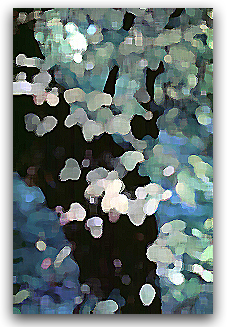
Elder Alone in a Cemetery
By Rosalie Franklin
There’s an elder growing between two tall gravestones in the Old Cemetery.
Is there any significance in the fact that it has chosen that spot?
The cemetery is in an open, cold, harsh area, but the lush green growth and tender young flower buds show no sign of suffering. It appears to have chosen its spot well.
There are other similar sites and yet it is the only elder in the entire cemetery.
This makes me curious.
After all, elders are well known for seeding quite readily. They are fast growing and have always been a valuable addition to the hedgerows of England. Hardy and known to be a long lived, they proliferate happily.
If you look around the older homes of the Ballarat area, there is always at least one elder growing there. If your neighbour had one, chances are, you would end up with one too. In olden days, it was quite a welcome addition to the garden, as it had so many uses for the household. I could list so many, but here are just a few examples: a tea made of elderflowers, with yarrow and peppermint, for the onset of colds; elderflower water for the complexion; and of course, the famous elderflower champagne and elderberry wine. Elderberry syrup made a nutritious drink for the family as well. At the height of its popularity, orchards of elder were grown to cater to the demand for the berries.
There was the added benefit of knowing that the elder could shield the
house from lightening damage and any unlucky people who might be caught
out in a storm could shelter beneath without fear.
So elders were prolific, new seedlings coming up anywhere in well cultivated
soil.
Why would an old cemetery be so lacking in these valued plants, when the conditions there seem to suit them so well?
Maybe they were cut down. I didn’t see any stumps or old sites. But if this happened, I hope those responsible asked permission. What were the chances, do you think? No native countryman of England or Europe would have wielded an ax at an elder with too much enthusiasm.
A female tree spirit, or dryad, is said to inhabit the elder and when it is cut, the elder ‘bleeds’ red sap. So the spirit’s permission must first be obtained. The following, if recited while kneeling, gives the spirit time to move on:
Lady Ellhorn, give me of thy wood,
And I will give thee of mine,
When I become a tree.
This is not the only magic associated with the elder. It’s a plant
steeped in ancient traditions and folklore. There is a long held belief
that planting an elder near the house guards against evil spirits.
Is this the reason the elder was found near the entrances to ancient British long barrows or burial mounds? The tradition certainly continued over hundreds of years. Throughout Britain and Europe, a sprig of Elder would even be planted in a grave.
The female spirit of the elder helped lost souls find their way on the next stage of their journey, without fear of attack by any unsavory or mischievous spirits before they reached the Underworld.
So, could this be why it has chosen this particular position in this cemetery? Does it mean that someone amongst those buried in one, or other, or perhaps both, of the graves had not yet continued on the next stage of their journey, and maybe had some special need? Was there a fear of some daemon lurking there, hindering some poor soul’s progress?
If so, it has been a long agonizing wait, as this elder is only young. The first burials in these graves took place within a month of each other in 1871. There are ten people buried there altogether, the last one in 1927. There are three very young babies, one child and various parents buried there. Maybe there was one there still grieving, unwilling to let go, scared that the soul of a young one was threatened in some way.
Or maybe something did lurk there, and the elder has chosen to establish itself very close to the threat of some malevolent spirit.
Now the elder spirit will ensure that calm and peace reign there. No evil spirit would dare to enter this area, if the elder’s reputation is at all true.
From now on, as it grows, its branches will spread out further and influence a larger area. Given a chance, it could spread its seeds further ensuring the whole cemetery is well guarded.
During my visit, this one Elder had still to reach the height of the two headstones. Is it strong enough to have achieved its allotted task? I believe it has.
Is there any way of knowing?
I came across this interesting observation on the elder’s affiliation with cemeteries.
Canon Ellacombe, in his book, In A Gloucestershire Garden, written in 1895, states that in the Tyrol "An Elder bush, trimmed into the form of a cross, is planted on a new-made grave, and if it blossoms, the soul of the person beneath it is happy."
Well, the one I saw grew wild and free, but it will be flowering profusely within the next month.
What a comforting thought for any relatives who might visit this site at this time of year.
It would be nice to think such a lovely old tradition could continue, and that all souls, whether still in this world, or having passed over, could gain consolation from the comforting presence of an elder nearby.